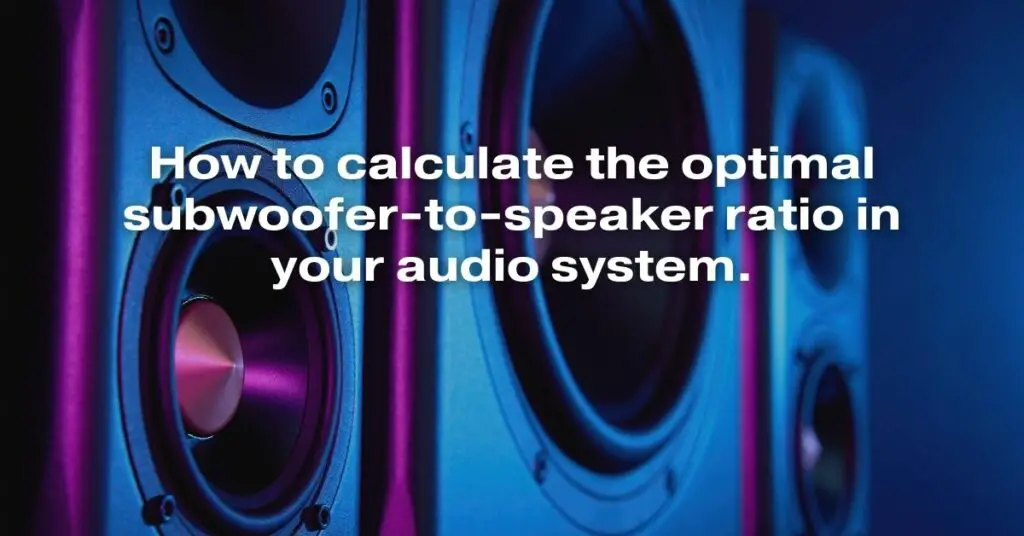Achieving a well-balanced and harmonious sound system requires careful consideration of the various components involved, and the subwoofer-to-speaker ratio plays a crucial role in this endeavor. A subwoofer, responsible for reproducing low-frequency sounds, must seamlessly integrate with the main speakers to deliver a cohesive and immersive audio experience. Striking the perfect balance between subwoofer and speaker output ensures that the low-end frequencies blend seamlessly with the overall soundscape, without overpowering or underwhelming the listener.
Understanding Subwoofer Sensitivity and Speaker Sensitivity
Before delving into the intricacies of calculating the optimal subwoofer-to-speaker ratio, it’s essential to grasp the concept of speaker sensitivity and subwoofer sensitivity. Speaker sensitivity, measured in decibels (dB), indicates how efficiently a speaker converts electrical energy into sound. A higher sensitivity rating implies that the speaker produces a louder sound for a given amount of power. Similarly, subwoofer sensitivity measures the efficiency of a subwoofer in converting electrical energy into low-frequency sound waves.
Determining the Optimal Subwoofer-to-Speaker Ratio
The optimal subwoofer-to-speaker ratio depends primarily on the sensitivity ratings of both components. A general rule of thumb suggests that the subwoofer’s output should be approximately half that of the main speakers. However, this guideline can vary depending on personal preferences and the specific characteristics of the listening environment.
To calculate the optimal subwoofer-to-speaker ratio, follow these steps:
-
Determine the sensitivity of your speakers and subwoofer. This information can usually be found in the product specifications or manuals.
-
Calculate the difference in sensitivity between the speakers and the subwoofer. Subtract the subwoofer’s sensitivity from the speaker’s sensitivity.
-
Divide the difference in sensitivity by 2. This value represents the optimal subwoofer-to-speaker ratio in decibels (dB).
For instance, if your speakers have a sensitivity of 88 dB and your subwoofer has a sensitivity of 92 dB, the difference in sensitivity is 4 dB. Dividing this difference by 2 yields an optimal subwoofer-to-speaker ratio of -2 dB. This means that the subwoofer’s output should be 2 dB lower than the main speakers’ output.
Fine-Tuning the Subwoofer-to-Speaker Balance
Once you’ve calculated the optimal subwoofer-to-speaker ratio, it’s time to fine-tune the balance using your audio system’s settings. Most AV receivers or amplifiers provide individual volume controls for the subwoofer and main speakers. Adjust these controls until you achieve a balanced and pleasing sound.
Remember that personal preferences play a significant role in determining the ideal subwoofer-to-speaker balance. Some listeners prefer a more pronounced bass presence, while others prefer a subtler low-end response. Experiment with different settings to find the balance that suits your taste and listening environment.
Additional Considerations
Apart from the sensitivity ratings, other factors can influence the optimal subwoofer-to-speaker ratio:
-
Room Size and Acoustics: Larger rooms generally require a more powerful subwoofer to fill the space adequately. Additionally, room acoustics can affect how bass frequencies are perceived.
-
Music Genre and Personal Preferences: Different music genres have varying bass requirements. For instance, genres like hip-hop and electronic music often demand a more prominent bass presence compared to genres like classical or jazz.
-
Subwoofer Placement: The placement of the subwoofer within the room can significantly impact its performance. Experiment with different positions to find the placement that delivers the most balanced and even bass response.
Achieving the optimal subwoofer-to-speaker ratio requires a combination of careful calculations, fine-tuning, and personal preference adjustments. By considering the sensitivity ratings, room characteristics, music genres, and personal preferences, you can create a harmonious audio system that delivers a truly immersive and satisfying listening experience.


